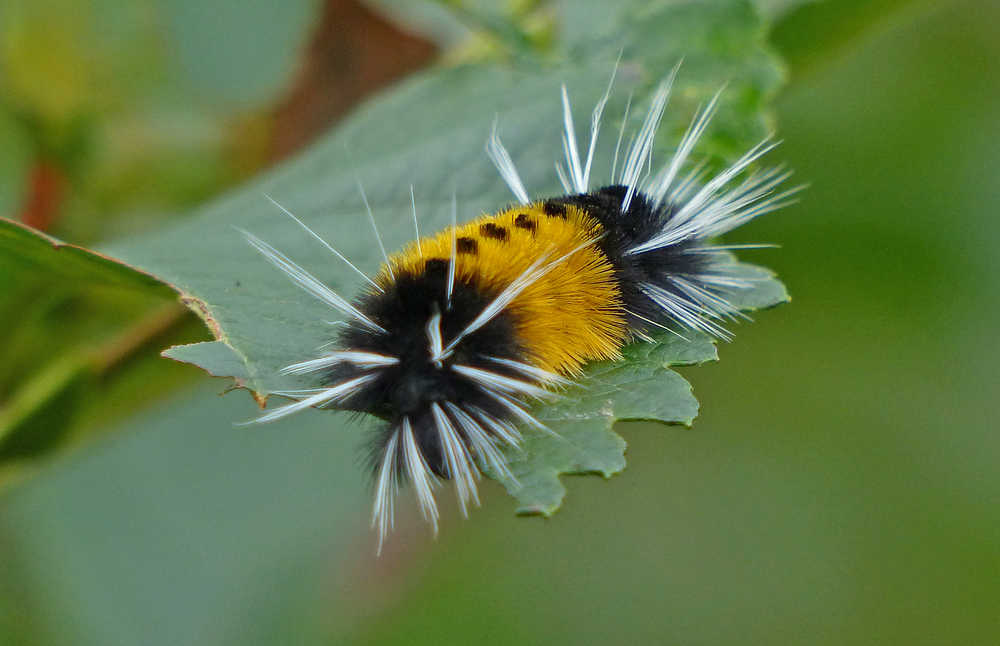In late August and early September, Juneau folks frequently remarked on the numbers of fuzzy, orange and black caterpillars in their gardens or crawling over paths and roadways. These are woolly bears, the last larval stage (or instar) of the spotted tussock moth (Lophocampa maculata). Ours is just one of several species called woolly bears, most of which belong to a large taxonomic group known, in general, as tiger moths.
Quite a lot of fascinating things are known about tiger moths: Some of them can hear the sonar clicks of foraging bats and produce their own clicks to confuse and deter an attacking bat. Some of them can extract plant toxins by puddling some saliva on a leaf and lapping up the dissolved chemicals. Some of the caterpillars have stinging hairs that can irritate sensitive human skin, and so on. But whether or not these features are found in our species is uncertain.
Likewise, I have not found solid answers as to what the adult moths of our species feed on, where the females lay their eggs, or the favorite leaves of the local caterpillars. It’s rather frustrating! But as more than one good naturalist has said: The first and most important step in science is to ask a question! (The second step is then to ask it in a way that yields answers, often by designing testable hypotheses). Answers eventually emerge when the right observations or experiments are done. So, I’ll stifle my frustration, for now, and proceed with some things we do know about woolly bears, although more questions will certainly arise.
The black-and-orange-banded woolly bears that wandered around in late summer exhibit what is usually considered to be warning coloration, an adaptation that tells would-be predators that this prey is dangerous, poisonous or distasteful, and thus fends off many attacks. This adaptation is shared, for example, with black-and-yellow bumblebees, black-and-orange monarch butterflies, and black-and-yellow-and-red coral snakes, all of which can damage an attacker in some way, and the various harmless species that mimic this coloration to fool their own attackers. But the black-and-orange-banded caterpillar is the fifth and last instar of the caterpillar, and it is the only one of the instars that has this coloration. This leads, of course, to questions: If the warning coloration in fact warns would-be predators of a distasteful prey, why is it found only in the last instar, and also not in the tan and yellow adult moth?
Whence cometh the name of spotted tussock moth? I inspected every woolly bear I found (and rescued a few foolhardy ones on the pathway from certain stomping), but none of them had detectable spots (and the adults are not spotty).
It turns out that Lophocampa maculata has a wide geographic distribution over much of North America. There are substantial differences, both among and within regions, in color (yellow vs orange band, width of black bands), the number and length of the white plumes that emerge from the fuzzy body, and in the presence of dark spots along the midline of the yellow or orange band. The population that occurs here is thought to belong to the race that ranges through the Rocky Mountains and westward to the coast in B.C. and Alaska. A different race is found in coastal California and yet another in coastal Washington, Oregon and Vancouver Island.
Black midline spots are known from several of these geographic races (hence the name, I presume), but NOT from the one that was thought to occur here. So when several Juneau observers reported seeing (and photographing) caterpillars with black spots on the back, it raised more questions: Are genes from the coastal populations to the south now moving north? If so, how is that happening? Are there environmental changes that foster the spots?
All those woolly bears trekking about in late summer were looking for a place to build a hibernation cocoon. There they will spend the winter, emerging in spring as yellow and tan moths. It takes many hours for a caterpillar to build a cocoon from silk and its own hairs. Check out a time-lapse video by Bob Armstrong on naturebob.com!
• Mary F. Willson is a retired professor of ecology.
Read more of Mary Willson’s columns:
Off the Trails: The life of bumblebees

